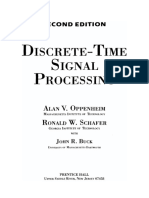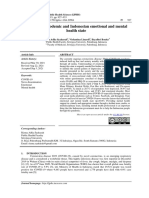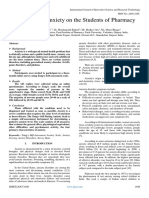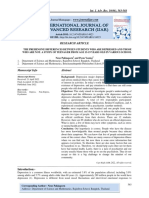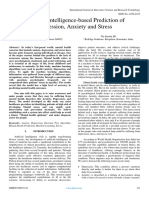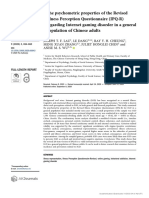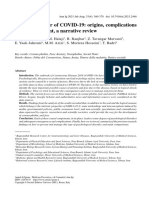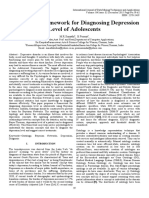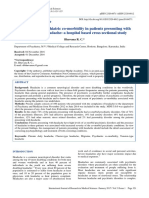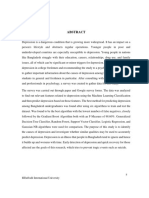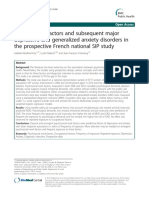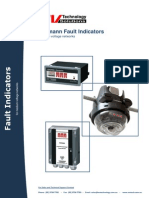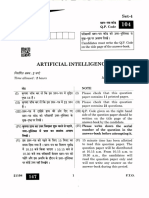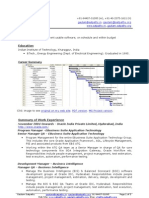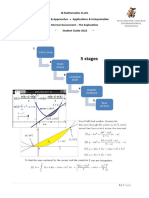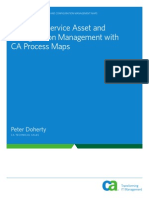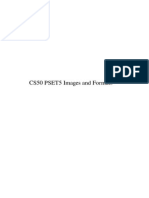Professional Documents
Culture Documents
Artificial Neural Network Prediction Model For Anxiety and Depression of An Individual On The Impact of COVID-19 Lockdown in Ethiopia
Original Title
Copyright
Available Formats
Share this document
Did you find this document useful?
Is this content inappropriate?
Report this DocumentCopyright:
Available Formats
Artificial Neural Network Prediction Model For Anxiety and Depression of An Individual On The Impact of COVID-19 Lockdown in Ethiopia
Copyright:
Available Formats
Volume 6, Issue 3, March – 2021 International Journal of Innovative Science and Research Technology
ISSN No:-2456-2165
Artificial Neural Network Prediction Model for
Anxiety and Depression of an Individual on the
Impact of COVID-19 Lockdown in Ethiopia
Sebahadin Nasir 1*, Md Nasre Alam2, Anteneh Tiruneh 3, Demeke Getaneh 4
Woldia University, Department of Computer Science, Woldia, Ethiopia
ABSTRACT:- COVID-19 Lockdown causes different students and people affected by depression and anxiety and
health problems in the society of Ethiopia. Among these commit suicide in the pandemic [3]
problems mental health problem such as anxiety,
depression, panic and fear are common. This research Depression is a disorder that affects how you feel,
aimed to redesign a neural network model of an anxiety behave and the way how you think. Depression is a bad
and depression based on Hospital Anxiety and mood that causes sadness and loss of interest and it can lead
Depression Score (HADS) measurement techniques. We to different physical and emotional problems. Someone who
collected 713 data from different individuals including affected by depression may not able to perform his day to
students, working and non-working male and female age day activities, and occasionally he/she may fell as if life
group from 16 to 55 using online survey. In order to isn’t worth living [4]. Nowadays depression is foremost
online survey, we prepared 7 questions using HADS contributor to the worldwide burden of disease and it affects
standard for anxiety and depression. Each of these people in any societies through the world. In 2012,
questions has four answer scores from 0 to 3. We depression is estimated to affect 350 million people [5].
generate neural network model on the basis of Environmental factors, personality, genetics and
participant response and HADS measurement technique biochemistry are some of the factors of depression [6].
in order to classify the level of Anxiety and Depression. According to oxford dictionary anxiety is a strong desire or
The level of anxiety and depression can be normal, mild, concern to do something or for something to happen and it is
moderate and severe. The model was tasted and its also defined as a feeling of worry, nervousness, or unease
specificity was 0.997940975 for anxiety and 0.996577687 about something with an uncertain outcome [7]. There is
for depression. We achieved the sensitivity value for different classification of anxiety and there are different risk
anxiety is 0.926666667 and for depression is factors of anxiety among this stress due to an illness, stress
0.945205479. We compared the model accuracy buildup, Trauma, other mental health disorder and drugs or
manually using HADS technique. We found the Average alcohol [8]. Feeling faint or dizzy, dry mouth, sweating,
Percentage Value (APV) 0.017379846 and 0.018365 for apprehension and worry, restlessness, distress and fear are
anxiety and depression respectively. This study can some of the symptoms of an anxiety attack [9]. The causes
further designed to recommend some advices on what an of both anxiety and depression are multifactorial, including
individual may do or what kind of measurements they biological, economic, social, environmental and cultural.
must do in each level of Anxiety and depression. Diagnosis of it is made by psychiatrists or psychologists
according to Diagnostic and Statistical Manual of Mental
Keywords:- Anxiety, Depression, COVID-19, Artificial Disorders (DSM)-5 [10] or International Classification of
Neural Network, Hospital Anxiety and Depression Scale. Diseases (ICD) 10 [11].
I. INTRODUCTION Machine-learning approaches is better than traditional
statistical prediction models on recognizing multipart
COVID-19 is an illness which stands for corona virus contours and patterns in data, and preventing hypothetically
disease that caused by a virus that can spread from person to imprecise model specifications [12]. Machine learning and
person. As World Health Organization (WHO) reported that data mining methods is used in health centers to diagnose
the COVID-19 was first identified in China, Wuhan city and complex diagnosis based on the patient’s history and this
spread throughout the world. In 2021 more than 80,000,000 can be used for making logical decisions. Diagnosis of
cases reported [1]. According to the new survey done by anxiety disorders is a very complex and challenging task.
WHO, the COVID-19 pandemic has disordered mental Thus using machine learning, an anxiety can be diagnosis
health service demand is increasing in the society which is with the high accuracy [13]. Articial Neural Networks
93% of countries worldwide. From depression and anxiety (ANNs) are densely interconnected and adaptive processing
alone approximately 1 trillion united states dollar economic units, with an inherent ability for learning from experience
productivity is lost in each year worldwide [2]. In Ethiopia, and discovering new knowledge [14]. Hospital anxiety and
more than 26 million students were distorted during the depression score (HADS) is a measurement tool for clinical
COVID -19 pandemic and it is reported in news a number of practice and research. It was designed to measure anxiety
and depression in general patients in health centers [15]. It is
IJISRT21MAR692 www.ijisrt.com 1221
Volume 6, Issue 3, March – 2021 International Journal of Innovative Science and Research Technology
ISSN No:-2456-2165
simple and easy to use calculate the level of anxiety and learning algorithms. They used python programming with
depression of an individual’s[16]. CNN for modeling experiments that scores accuracy and
recall of 78% and 0.72, respectively.
Different authors conduct a research on machine
learning model for prediction of anxiety and depression. II. METHOD AND EXPERIMENT
Lana G. Tennenhousea and et al. [17] did a study on
machine-learning models for depression and anxiety in 2.1 Data Collection
individuals with immune-mediated inflammatory disease. For this study, the data was collected from 1607
They used Patient-reorted out-come measures (PROMs) to individuals using Google forms. Among these 1607
predict anxiety and depression of an individual with individuals who filled the online form 778 are females and
immune-mediated inflammatory disease (IMID) using 829 were male, age between 16- 55, it includes students,
machine learning. They collected 637 data to train the employed, unemployed and household. In the online form
machine, logistic regression (LR), neural network (NN), and 14 questions where used in the questioner, 7 for anxiety and
random forest (RF) technique was used. However, their 7 for depression. The questioner used was based on HADS,
model was designed anxiety and depression caused by Hospital anxiety and depression scale and edited according
deregulation of the immune system. to Ethiopian context [18]. The question used for Anxiety
and depression used in the online questioner is listed below:
Anu priyaa and et al. designed a model that predicting
anxiety, depression and stress in modern life using machine
Anxiety Depression
I feel tense or 'wound up'? I still enjoy the things I used to enjoy?
I get a sort of frightened feeling as if something awful is about I can laugh and see the funny side of things?
to happen? I feel cheerful?
Worrying thoughts go through my mind? I feel as if I am slowed down?
I can sit at ease and feel relaxed? I have lost interest in my appearance?
I get a sort of frightened feeling like 'butterflies' in the I look forward with enjoyment to things?
stomach?
I feel restless as I have to be on the move? I can enjoy a good book or radio or TV program?
I get sudden feelings of panic?
The expected answer and score point for each question in the questioner for Anxiety and depression is shown below in Table
1[18].
Table 1. Anxiety and depression questioner answer and score.
Anxiety Depression
Answer Score Answer Score
Very definitely and quite badly 3 Not at all 0
Yes, but not too badly 2 Sometimes 1
A little, but it doesn't worry me 1 Very often 2
Not at all 0 Nearly all the time 3
The collected data for Anxiety and depression score level of individual was categorized as normal, mild, severe and
moderate using HADS technique [18]. The four categories such as normal, mild, severe and moderate are coded using decimal
numbers as 1, 2, 3 and 4 respectively and these used for training in the neural network. In Figure 1 the questioner collected from
each person is coded from p1-Ans to p1607-Ans and the questions are coded horizontally with their respective answer score
vertically.
IJISRT21MAR692 www.ijisrt.com 1222
Volume 6, Issue 3, March – 2021 International Journal of Innovative Science and Research Technology
ISSN No:-2456-2165
(a) Anxiety (b) Depression
Figure 1: Anxiety and Depression collected questioner answer of an individual
2.2 Experiment
MatLab programming language was used to train and 2.4 Training Neural Network
test the model generated. It is a High-level language for The multilayer feed forward network can be trained for
technical computing and interactive environment used to function approximation pattern recognition [20]. In
perform computationally intensive tasks faster that other implementing the training there are two modes such as
traditional programming languages like c and c++ [19]. The incremental mode and batch mode. In incremental mode, the
network is created to recognize the Pattern using gradient is calculated and the weights are updated after
feedforward networks that can be trained to classify inputs every single input is applied to the network. In batch mode,
(each score/answer of the questions shown in Figure 1) before the weights are updated all the inputs in the training
according to target classes (anxiety and depression class set are applied to the network. In using the Neural Network
calculated using HADS). With the help of pattern network Toolbox software, batch training is significantly faster and
20 hidden layers are used as shown in neural network design produces smaller errors than incremental training in most
Figure 2 below. problems [21] .
2.3 Dividing Data The Scaled Conjugate Gradient algorithm is used by
In multilayer networks training, the 712 data is divided default by pattern recognition. The network is trained using
into three subsets as training, validation and testing sets. In Scaled conjugate gradient back propagation algorithm using
the first subset, among all data 70% is used for training, the input, target and the created network parameters. There
which is used for computing the gradient and updating the are 7 inputs and 1 output for both anxiety and depression
network weights and biases. The second subset is the training as shown in Figure 2 below. The training was
validation set and here we used 15% of all data. The third stopped at epoch 54, it takes 0.22 seconds long, with the
subset is testing and similarly with the validation 15% of all performance 0.664, at 1.29 performance gradient and with 6
data is used. validation performance.
IJISRT21MAR692 www.ijisrt.com 1223
Volume 6, Issue 3, March – 2021 International Journal of Innovative Science and Research Technology
ISSN No:-2456-2165
Figure 2: The design of Artificial Neural Network
2.5 Training performance validation and testing
The training performance shows the final mean square error is small at epoch 54 as shown in Figure 3. In the figure the
validation and test set error have similar characteristics and it achieves the best validation performance 0.049968 at iteration 48
and no significant over fitting occurred at iteration 48.
Figure 3. Training performance validation and testing
III. RESULTS AND DISCUSSIONS
The accuracy result of the model is compared with the manually calculated value by hospital anxiety and depression score.
The anxiety and depression error rate measured in absolute percentage value (APV) of 0.017379846 and 0.018365 respectively.
Moreover the sensitivity is calculated for anxiety and depression using APV as 0.926666667 and 0.945205479 respectively, the
specificity of the anxiety and depression is 0.997940975 and 0.996577687 respectively.
IJISRT21MAR692 www.ijisrt.com 1224
Volume 6, Issue 3, March – 2021 International Journal of Innovative Science and Research Technology
ISSN No:-2456-2165
Table 2: Result of the designed model of an anxiety and depression
True Class(Anxiety and depression ) using HADS
Class Precision Sensitivity Specificity F1-score Accuracy Error Rate
Anxiety Normal 0.995271868 0.976798144 0.994630872 0.985948 0.985065 0.014934661
Mild 0.916363636 0.984375 0.95481336 0.949153 0.964706 0.035294118
Moderate 0.968023256 0.982300885 0.991324921 0.97511 0.989421 0.010578718
Severe 0.978873239 0.926666667 0.997940975 0.952055 0.991288 0.008711886
Predicted class using ANN
APV 0.964633 0.967535174 0.984677532 0.9655665 0.98262 0.017379846
Depression Normal 0.985176739 0.998843931 0.982479784 0.991963 0.991288 0.008711886
Mild 0.964705882 0.917910448 0.981052632 0.940727 0.958277 0.041722746
Moderate 0.957831325 0.969512195 0.989053948 0.963636 0.985065 0.014934661
Severe 0.965034965 0.945205479 0.996577687 0.955017 0.99191 0.008089608
APV 0.968187 0.957868 0.987291 0.962836 0.981635 0.018365
IV. CONCLUSION conditions/depression/symptoms-causes/syc-
20356007, last accessed on May 2020.
In this study, our main finding shows neural network [5]. DEPRESSION, A Global Public Health Concern,
model for prediction of anxiety and depression caused by Developed by Marina Marcus, M. Taghi Yasamy,
COVID -19 lockdown in Ethiopia was designed and gives Mark van Ommeren, and Dan Chisholm, Shekhar
us a good result. During the model generation we collected Saxena WHO Department of Mental Health and
713 data using online survey in Ethiopia and in answering Substance Abuse, 2012
the questioner employed, unemployed, student, female male [6]. American Psychiatric Association, Risk Factors for
and age between 16 up to 55 was participated. Based on the Depression, available at
standard HADS, 7 question used form both anxiety and https://www.psychiatry.org/patients-
depression. In the experiment, feedforward neural network families/depression/what-is-depression last accessed
was used and it achieves a best accuracy of 0.049968 at on July 2020.
iteration 54. The overall result of specificity and sensitivity [7]. Definition from oxford dictionary,
in detection of Anxiety was 0.997940975 and 0.926666667 https://languages.oup.com/google-dictionary-en/
respectively and the overall specificity and sensitivity result [8]. Anxiety disorders, Available at
of depression was 0.996577687 and 0.945205479 https://www.mayoclinic.org/diseases-
respectively. The result of the neural network model was conditions/anxiety/symptoms-causes/syc-20350961,
compared with the ground truth value calculated manually Last accessed on March 02, 2020
using HADS and the average percentage error of the model [9]. Everything You Need to Know About Anxiety,
in anxiety and depression detection is 0.017379846 and https://www.healthline.com/health/ anxiety#anxiety-
0.018365 respectively. In the future we will further consider attack
attributes like age, income level and gender in generating [10]. American Psychiatric Association Force DSMT.
the model. Diagnostic and statistical manual of mental disorders:
DSM-5. American Psychiatric Association. 2016;
REFERENCES 2013.
[11]. World Health Organization. The ICD-10 classification
[1]. Worldometers, “corona virus updates”, available at of mental and behavioural dis-orders: diagnostic
https://www.worldometers.info/ last accessed on criteria for research. 1993.] [A Neural Network
January, 2021 Based M o del for Predicting Psychological Conditions
[2]. World Health Organization, “ COVID-19 disrupting [12]. Lana G. Tennenhousea, Ruth Ann Marrie, Charles N.
mental health services in most countries, WHO Bernstein, Lisa M. Lix "Machine-learning models for
survey”, available at https://www.who.int/news/, Last depression and anxiety in individuals with immune-
accessed on June, 2020. mediated inflammatory disease" Journal of
[3]. UNICEF, “The case for safely reopening schools in Psychosomatic Research 134, 110126, 2020.
Ethiopia”, Available at [13]. Emmanuel G. Pintelas, Theodore Kotsilieris, Ioannis
https://www.unicef.org/ethiopia/stories/case-safely- E. Livieris and Panagiotis Pintelas, “A review of
reopening-schools-ethiopia, Last accessed on machine learning prediction methods for anxiety
November, 2020. disorders” , ResearchGate, DOI:
[4]. Depression (major depressive disorder), Mayo Clinic 10.1145/3218585.3218587, Conference Paper · July
available at https://www.mayoclinic.org/diseases- 2018
IJISRT21MAR692 www.ijisrt.com 1225
Volume 6, Issue 3, March – 2021 International Journal of Innovative Science and Research Technology
ISSN No:-2456-2165
[14]. C.M. Bishop. 1995. Neural Networks for Pattern [18]. Hospital Anxiety and Depression Scale (HADS),
Recognition. Oxford. Availabel at
[15]. Zigmond AS, Snaith RP. The Hospital Anxiety and https://www.svri.org/sites/default/files/attachments/20
Depression Scale. Acta Psychiatr Scand 1983; 67:361– 16-01-13/HADS.pdf Last Accessed on March 06,
370. 2020.
[16]. McManus S, Meltzer H, Brugha T, Bebbington P, [19]. University of Birmingham, “About
Jenkins R, eds. Adult Psychiatric Morbidity in MATLAB”Available at, https://intranet.birmingham
England 2007. Results of Household Survey. .ac.uk/collaboration/hpc-
http://www.hscic.gov.uk/catalogue/ PUB02931/adul- research/matlab/about/index.aspx#:~:text= MATLAB.
psyc-morb-res-hou-sur-eng-2007-rep.pdf (February , Last Accessed on March 1, 2021.
2014, date last accessed). [20]. Feedforward Neural Network, B.K. Lavine, T.R.
[17]. Lana G. Tennenhousea and et al. [ ] Lana G. Blank, in Comprehensive Chemometrics, Volume 3,
Tennenhousea, Ruth Ann Marrie, Charles N. ScienceDirect, 2009
Bernstein, Lisa M. Lix "Machine-learning models for [21]. MathWorks, "Train and Apply Multilayer Shallow
depression and anxiety in individuals with immune- Neural Networks" Available at
mediated inflammatory disease" Journal of https://www.mathworks.com/help/deeplearning/
Psychosomatic Research 134, 110126, 2020. ug/train-and-apply-multilayer-neural-networks.html,
Last Accessed on March 1, 2021.
AUTHORS
Sebahadin Nasir Shafi is graduated bsc in computer science from Ambo University in 2012 and he
received his msc in computer science from Addis Ababa university department of science in 2017.
Currently he is working as lecturer and researcher at Woldia university department of computer
science. Moreover he is working on position of an associate registrar at Woldia university technology
Institute. He is working and interested in research areas of computer vision, digital image processing
and patterns recognition, machine learning and Artificial intelligence wireless networking.
Md. NasreAlam received his bachelor in computer application (bca) from m.c.r.p university, bhopal,
india in 2004, and m.sc. In computer science from hamdard university, new delhi, india in 2007. He
did phd at the graduate school of it and telecommunication engineering in inha university, incheon,
south korea. From 2014 to 2017 he worked as post doctor in chonbuk national university, jeonju,
south korea. Now he is serving as assistant professor at department of computer science, Woldia
university, Ethiopia. His research interests are wireless sensor networks, wireless communications,
wireless ad- hoc networks, wireless body area networks and wireless personal area networks.
Anteneh Tiruneh Terefe is MSc graduate from Adama Science and Techology University in School of
Computing in 2017. Currently he is working as lecturer and researcher at Woldian University Institute
of Technology Department of Computer Science and he is interested in Internet of things and data
science research.
Demeke Getaneh Mergia received his bachelor degree in Software Engineering from Adama
University, Ethiopia in 2013 and MSc. Degree in Software Engineering from Adama University in
2018. Since 2014 up to 2016 he is working as Assistant lecturer at institute of technology, School of
Computing, department of computer Science in Woldia University, Ethiopia. Since March 2018 he
has been working as a Lecturer in Woldia University. Besides teaching he has been doing researches,
technology transfer projects, and community services. His area of interest includes software
engineering, wireless sensor networks, wireless Ad Hoc network, AI, Machine Learning and Data
Science.
IJISRT21MAR692 www.ijisrt.com 1226
You might also like
- Discrete-Time Digital Signal Processing - Oppenheim, Schafer & Buck PDFDocument895 pagesDiscrete-Time Digital Signal Processing - Oppenheim, Schafer & Buck PDFKishanNo ratings yet
- Wearable AI For Anxiety and Depression Detection - ReviewDocument21 pagesWearable AI For Anxiety and Depression Detection - Reviewaria3taryNo ratings yet
- A Machine Learning Based Depression AnalysisDocument6 pagesA Machine Learning Based Depression AnalysisMayurNo ratings yet
- Research Proposal: (Company Name)Document9 pagesResearch Proposal: (Company Name)Sagar SunuwarNo ratings yet
- Deep Learning For Prediction of Depressive Symptoms in A Large Textual DatasetDocument24 pagesDeep Learning For Prediction of Depressive Symptoms in A Large Textual DatasetAmith PrasanthNo ratings yet
- A Mental State Knowledge-Aware and Contrastive Network For EarlyDocument16 pagesA Mental State Knowledge-Aware and Contrastive Network For EarlyMayurNo ratings yet
- Determinants of Mental Health Status Using Depression Anxiety Stress Scales During The COVID-19 Pandemic: A Systematic ReviewDocument8 pagesDeterminants of Mental Health Status Using Depression Anxiety Stress Scales During The COVID-19 Pandemic: A Systematic ReviewIJPHSNo ratings yet
- Psychological Impact of Covid 19 PDFDocument9 pagesPsychological Impact of Covid 19 PDFAayam vaidyaNo ratings yet
- An In-Depth Analysis of Machine Learning Approaches To Predict DepressionDocument12 pagesAn In-Depth Analysis of Machine Learning Approaches To Predict DepressionDilshan SonnadaraNo ratings yet
- COVID-19 Infodemic and Indonesian Emotional and Mental Health StateDocument7 pagesCOVID-19 Infodemic and Indonesian Emotional and Mental Health StateIJPHSNo ratings yet
- A Survey On Anxiety On The Students of PharmacyDocument4 pagesA Survey On Anxiety On The Students of PharmacyInternational Journal of Innovative Science and Research TechnologyNo ratings yet
- Medicine: Mutual Associations Between Intellectual Disability and Epilepsy-Related Psychiatry DisabilityDocument5 pagesMedicine: Mutual Associations Between Intellectual Disability and Epilepsy-Related Psychiatry DisabilityAlfredo PérezNo ratings yet
- Psyche BoostDocument1 pagePsyche Boostmahrrby5No ratings yet
- The Prehensive Differences Between Students Who Are Depressed and Those Who Are Not. A Study of Teenager From Age 15-19 Years Old in Various SchoolDocument6 pagesThe Prehensive Differences Between Students Who Are Depressed and Those Who Are Not. A Study of Teenager From Age 15-19 Years Old in Various SchoolIJAR JOURNALNo ratings yet
- 1 Covi ContinenetesDocument9 pages1 Covi ContinenetesKpa LDNo ratings yet
- Depression Detection From Social Media Posts UsingDocument13 pagesDepression Detection From Social Media Posts UsingFS TamimNo ratings yet
- 2021 - Investigacion - Publicaciones - Detectaweb DistressDocument14 pages2021 - Investigacion - Publicaciones - Detectaweb DistressJose Antonio Piqueras RodríguezNo ratings yet
- Artificial Intelligence-Based Prediction of Depression, Anxiety and StressDocument7 pagesArtificial Intelligence-Based Prediction of Depression, Anxiety and StressInternational Journal of Innovative Science and Research TechnologyNo ratings yet
- The Need For Emotional Intelligence Training Education in Critical and Stressful Situations: The Case of Covid-19Document18 pagesThe Need For Emotional Intelligence Training Education in Critical and Stressful Situations: The Case of Covid-19jade tagabNo ratings yet
- Annals of Psychiatry and Clinical NeuroscienceDocument6 pagesAnnals of Psychiatry and Clinical NeuroscienceFiorenzo TassottiNo ratings yet
- To Study The Effect of Lockdown On Physical, Mental and Emotional Health of Common PeopleDocument9 pagesTo Study The Effect of Lockdown On Physical, Mental and Emotional Health of Common PeopleInternational Journal of Innovative Science and Research Technology100% (1)
- 4 Ijmtst0811005Document5 pages4 Ijmtst0811005Vijay MuniNo ratings yet
- Prediction of Depression Severity Based On The Prosodic and Semantic Features With Bidirectional LSTM and Time Distributed CNNDocument15 pagesPrediction of Depression Severity Based On The Prosodic and Semantic Features With Bidirectional LSTM and Time Distributed CNNPrerna RajNo ratings yet
- Effect of Childhood Psychological TraumaDocument23 pagesEffect of Childhood Psychological TraumaSea SaltNo ratings yet
- Assessing The Relationship Between Anxiety Levels and Panic Attacks Among The Youth in ShimlaDocument52 pagesAssessing The Relationship Between Anxiety Levels and Panic Attacks Among The Youth in ShimlaAni RudhNo ratings yet
- Study On Empowering Youth and Adults To Overcome Mental Health Hardships Using A Web ApplicationDocument6 pagesStudy On Empowering Youth and Adults To Overcome Mental Health Hardships Using A Web ApplicationInternational Journal of Innovative Science and Research TechnologyNo ratings yet
- Big Data Application: Study and Archival of Mental Health Data, Using MongodbDocument5 pagesBig Data Application: Study and Archival of Mental Health Data, Using MongodbNay Chi Than HtunNo ratings yet
- Jurnal 1Document10 pagesJurnal 1Mutiara UtamiNo ratings yet
- Post-Traumatic Stress Disorders Among The COVID-19 Survivors: Impact On Mental HealthDocument4 pagesPost-Traumatic Stress Disorders Among The COVID-19 Survivors: Impact On Mental Healthnashwamy04No ratings yet
- OMIarticleDocument9 pagesOMIarticlesowmiyajagan1509No ratings yet
- Depression Prediction Using Machine Learning: A ReviewDocument11 pagesDepression Prediction Using Machine Learning: A ReviewIAES IJAINo ratings yet
- Research Paper Mental DisordersDocument8 pagesResearch Paper Mental Disordersfvhdgaqt100% (1)
- Depression and HIV Disease Progression A Mini-ReviewDocument7 pagesDepression and HIV Disease Progression A Mini-Reviewrochmandrg dokter gigiNo ratings yet
- InsomniaDocument6 pagesInsomniasarhang talebaniNo ratings yet
- Phobia and Fear of COVID-19: Origins, Complications and Management, A Narrative ReviewDocument11 pagesPhobia and Fear of COVID-19: Origins, Complications and Management, A Narrative ReviewDivs Divination DivinaNo ratings yet
- Salud Mental y Covid 19 (2021)Document16 pagesSalud Mental y Covid 19 (2021)Rogger LuqueNo ratings yet
- 01 Ijpba 2082 23Document9 pages01 Ijpba 2082 23BRNSS Publication Hub InfoNo ratings yet
- BRM Research Paper 1Document15 pagesBRM Research Paper 1Bhagyasri PNo ratings yet
- Brain, Behavior, and Immunity: SciencedirectDocument7 pagesBrain, Behavior, and Immunity: SciencedirectMarinela MeliszekNo ratings yet
- Mdscan - An Explainable Artificial Intelligence Artifact For MentaDocument13 pagesMdscan - An Explainable Artificial Intelligence Artifact For Mentahegde247No ratings yet
- A Bayesian Framework For Diagnosing Depression Level of AdolescentsDocument4 pagesA Bayesian Framework For Diagnosing Depression Level of AdolescentsIIR indiaNo ratings yet
- Thought Visualisation Tool Hcist17 FinalDocument8 pagesThought Visualisation Tool Hcist17 FinalBegüm E. UyumazNo ratings yet
- Systematic Review and Meta-Analysis of Performance of Wearable Arti Ficial Intelligence in Detecting and Predicting DepressionDocument16 pagesSystematic Review and Meta-Analysis of Performance of Wearable Arti Ficial Intelligence in Detecting and Predicting DepressionAmith PrasanthNo ratings yet
- Suicide Risk Screening ScalesDocument7 pagesSuicide Risk Screening ScalesIJAR JOURNALNo ratings yet
- Group 6 Research Manuscript 1Document67 pagesGroup 6 Research Manuscript 1Dan EvanzNo ratings yet
- 2017 - SPRINGER - Emhealth Towards Emotion Health Through Depression Prediction and Intelligent Health Recommender SystemDocument11 pages2017 - SPRINGER - Emhealth Towards Emotion Health Through Depression Prediction and Intelligent Health Recommender SystemPriya KumariNo ratings yet
- Anxiety-Depressive Disorders in The General Population During A Period of Confinement in MoroccoDocument9 pagesAnxiety-Depressive Disorders in The General Population During A Period of Confinement in MoroccoIJAR JOURNALNo ratings yet
- 5.nijhawan VishaliDocument6 pages5.nijhawan VishaliAnonymous CwJeBCAXpNo ratings yet
- Addictive Behaviors ReportsDocument9 pagesAddictive Behaviors ReportsHafiz AliNo ratings yet
- 404 1609 1 PBDocument5 pages404 1609 1 PBRohamonangan TheresiaNo ratings yet
- Commentary Paper:: COVID-19 Pandemic and The Importance of Cognitive RehabilitationDocument5 pagesCommentary Paper:: COVID-19 Pandemic and The Importance of Cognitive Rehabilitationtri windartiNo ratings yet
- Analisis Jurnal Keperawatan JiwaDocument18 pagesAnalisis Jurnal Keperawatan JiwaEli SusilawatiNo ratings yet
- A Study To Assess The Perceived Stress Among Nursing Students During COVID-19 LockdownDocument7 pagesA Study To Assess The Perceived Stress Among Nursing Students During COVID-19 LockdownannuNo ratings yet
- An Overview of Indian Research in DepressionDocument19 pagesAn Overview of Indian Research in DepressionTanvi GargNo ratings yet
- 11 Original Research Article ADocument9 pages11 Original Research Article A07 Chinmayee MohapatraNo ratings yet
- O7kdbu MainDocument5 pagesO7kdbu MainMariana OliveiraNo ratings yet
- 201-15-3650-Paper Report-TariqulDocument33 pages201-15-3650-Paper Report-TariqulMd. Tariqul Islam 201-15-3650No ratings yet
- Vander Wal 2016Document8 pagesVander Wal 2016Kevin YonathanNo ratings yet
- Ansiedade 04Document9 pagesAnsiedade 04Karina BorgesNo ratings yet
- Occupational Factors and Subsequent Major Depressive and Generalized Anxiety Disorders in The Prospective French National SIP StudyDocument12 pagesOccupational Factors and Subsequent Major Depressive and Generalized Anxiety Disorders in The Prospective French National SIP StudylauraNo ratings yet
- The Phobia of the Modern World: Nomophobia: "Conceptualization of Nomophobia and Investigation of Associated Psychological Constructs"From EverandThe Phobia of the Modern World: Nomophobia: "Conceptualization of Nomophobia and Investigation of Associated Psychological Constructs"No ratings yet
- Factors Influencing The Use of Improved Maize Seed and Participation in The Seed Demonstration Program by Smallholder Farmers in Kwali Area Council Abuja, NigeriaDocument6 pagesFactors Influencing The Use of Improved Maize Seed and Participation in The Seed Demonstration Program by Smallholder Farmers in Kwali Area Council Abuja, NigeriaInternational Journal of Innovative Science and Research TechnologyNo ratings yet
- Study Assessing Viability of Installing 20kw Solar Power For The Electrical & Electronic Engineering Department Rufus Giwa Polytechnic OwoDocument6 pagesStudy Assessing Viability of Installing 20kw Solar Power For The Electrical & Electronic Engineering Department Rufus Giwa Polytechnic OwoInternational Journal of Innovative Science and Research TechnologyNo ratings yet
- Unmasking Phishing Threats Through Cutting-Edge Machine LearningDocument8 pagesUnmasking Phishing Threats Through Cutting-Edge Machine LearningInternational Journal of Innovative Science and Research TechnologyNo ratings yet
- An Industry That Capitalizes Off of Women's Insecurities?Document8 pagesAn Industry That Capitalizes Off of Women's Insecurities?International Journal of Innovative Science and Research TechnologyNo ratings yet
- Blockchain Based Decentralized ApplicationDocument7 pagesBlockchain Based Decentralized ApplicationInternational Journal of Innovative Science and Research TechnologyNo ratings yet
- Cyber Security Awareness and Educational Outcomes of Grade 4 LearnersDocument33 pagesCyber Security Awareness and Educational Outcomes of Grade 4 LearnersInternational Journal of Innovative Science and Research TechnologyNo ratings yet
- Insights Into Nipah Virus: A Review of Epidemiology, Pathogenesis, and Therapeutic AdvancesDocument8 pagesInsights Into Nipah Virus: A Review of Epidemiology, Pathogenesis, and Therapeutic AdvancesInternational Journal of Innovative Science and Research TechnologyNo ratings yet
- Parastomal Hernia: A Case Report, Repaired by Modified Laparascopic Sugarbaker TechniqueDocument2 pagesParastomal Hernia: A Case Report, Repaired by Modified Laparascopic Sugarbaker TechniqueInternational Journal of Innovative Science and Research TechnologyNo ratings yet
- Smart Health Care SystemDocument8 pagesSmart Health Care SystemInternational Journal of Innovative Science and Research TechnologyNo ratings yet
- Smart Cities: Boosting Economic Growth Through Innovation and EfficiencyDocument19 pagesSmart Cities: Boosting Economic Growth Through Innovation and EfficiencyInternational Journal of Innovative Science and Research TechnologyNo ratings yet
- Impact of Silver Nanoparticles Infused in Blood in A Stenosed Artery Under The Effect of Magnetic Field Imp. of Silver Nano. Inf. in Blood in A Sten. Art. Under The Eff. of Mag. FieldDocument6 pagesImpact of Silver Nanoparticles Infused in Blood in A Stenosed Artery Under The Effect of Magnetic Field Imp. of Silver Nano. Inf. in Blood in A Sten. Art. Under The Eff. of Mag. FieldInternational Journal of Innovative Science and Research TechnologyNo ratings yet
- Diabetic Retinopathy Stage Detection Using CNN and Inception V3Document9 pagesDiabetic Retinopathy Stage Detection Using CNN and Inception V3International Journal of Innovative Science and Research TechnologyNo ratings yet
- Visual Water: An Integration of App and Web To Understand Chemical ElementsDocument5 pagesVisual Water: An Integration of App and Web To Understand Chemical ElementsInternational Journal of Innovative Science and Research TechnologyNo ratings yet
- Compact and Wearable Ventilator System For Enhanced Patient CareDocument4 pagesCompact and Wearable Ventilator System For Enhanced Patient CareInternational Journal of Innovative Science and Research TechnologyNo ratings yet
- Harnessing Open Innovation For Translating Global Languages Into Indian LanuagesDocument7 pagesHarnessing Open Innovation For Translating Global Languages Into Indian LanuagesInternational Journal of Innovative Science and Research TechnologyNo ratings yet
- Air Quality Index Prediction Using Bi-LSTMDocument8 pagesAir Quality Index Prediction Using Bi-LSTMInternational Journal of Innovative Science and Research TechnologyNo ratings yet
- Predict The Heart Attack Possibilities Using Machine LearningDocument2 pagesPredict The Heart Attack Possibilities Using Machine LearningInternational Journal of Innovative Science and Research TechnologyNo ratings yet
- Keywords:-Ibadhy Chooranam, Cataract, Kann Kasam,: Siddha Medicine, Kann NoigalDocument7 pagesKeywords:-Ibadhy Chooranam, Cataract, Kann Kasam,: Siddha Medicine, Kann NoigalInternational Journal of Innovative Science and Research TechnologyNo ratings yet
- An Analysis On Mental Health Issues Among IndividualsDocument6 pagesAn Analysis On Mental Health Issues Among IndividualsInternational Journal of Innovative Science and Research TechnologyNo ratings yet
- Parkinson's Detection Using Voice Features and Spiral DrawingsDocument5 pagesParkinson's Detection Using Voice Features and Spiral DrawingsInternational Journal of Innovative Science and Research TechnologyNo ratings yet
- The Relationship Between Teacher Reflective Practice and Students Engagement in The Public Elementary SchoolDocument31 pagesThe Relationship Between Teacher Reflective Practice and Students Engagement in The Public Elementary SchoolInternational Journal of Innovative Science and Research TechnologyNo ratings yet
- The Making of Object Recognition Eyeglasses For The Visually Impaired Using Image AIDocument6 pagesThe Making of Object Recognition Eyeglasses For The Visually Impaired Using Image AIInternational Journal of Innovative Science and Research TechnologyNo ratings yet
- Advancing Healthcare Predictions: Harnessing Machine Learning For Accurate Health Index PrognosisDocument8 pagesAdvancing Healthcare Predictions: Harnessing Machine Learning For Accurate Health Index PrognosisInternational Journal of Innovative Science and Research TechnologyNo ratings yet
- Implications of Adnexal Invasions in Primary Extramammary Paget's Disease: A Systematic ReviewDocument6 pagesImplications of Adnexal Invasions in Primary Extramammary Paget's Disease: A Systematic ReviewInternational Journal of Innovative Science and Research TechnologyNo ratings yet
- Investigating Factors Influencing Employee Absenteeism: A Case Study of Secondary Schools in MuscatDocument16 pagesInvestigating Factors Influencing Employee Absenteeism: A Case Study of Secondary Schools in MuscatInternational Journal of Innovative Science and Research TechnologyNo ratings yet
- Dense Wavelength Division Multiplexing (DWDM) in IT Networks: A Leap Beyond Synchronous Digital Hierarchy (SDH)Document2 pagesDense Wavelength Division Multiplexing (DWDM) in IT Networks: A Leap Beyond Synchronous Digital Hierarchy (SDH)International Journal of Innovative Science and Research TechnologyNo ratings yet
- The Utilization of Date Palm (Phoenix Dactylifera) Leaf Fiber As A Main Component in Making An Improvised Water FilterDocument11 pagesThe Utilization of Date Palm (Phoenix Dactylifera) Leaf Fiber As A Main Component in Making An Improvised Water FilterInternational Journal of Innovative Science and Research TechnologyNo ratings yet
- Formulation and Evaluation of Poly Herbal Body ScrubDocument6 pagesFormulation and Evaluation of Poly Herbal Body ScrubInternational Journal of Innovative Science and Research TechnologyNo ratings yet
- Terracing As An Old-Style Scheme of Soil Water Preservation in Djingliya-Mandara Mountains - CameroonDocument14 pagesTerracing As An Old-Style Scheme of Soil Water Preservation in Djingliya-Mandara Mountains - CameroonInternational Journal of Innovative Science and Research TechnologyNo ratings yet
- The Impact of Digital Marketing Dimensions On Customer SatisfactionDocument6 pagesThe Impact of Digital Marketing Dimensions On Customer SatisfactionInternational Journal of Innovative Science and Research TechnologyNo ratings yet
- EKA3 - 1 Pag.20Document30 pagesEKA3 - 1 Pag.20Razvan MaresNo ratings yet
- 2024 AI Set-4Document11 pages2024 AI Set-4TanishNo ratings yet
- 7.6 Branch and Bound Method: C 1 1 0 0 0 Basic Variables Basic Basic Variables X X S S S Coefficient Variables ValuesDocument8 pages7.6 Branch and Bound Method: C 1 1 0 0 0 Basic Variables Basic Basic Variables X X S S S Coefficient Variables ValuesKowsalyaNo ratings yet
- Math 6 Plus Unit 7 Expressions and EquationsDocument17 pagesMath 6 Plus Unit 7 Expressions and EquationsridhaandeshpandeNo ratings yet
- FD9367-HV: Fixed Dome Network CameraDocument3 pagesFD9367-HV: Fixed Dome Network Camerajulian vargasNo ratings yet
- CEED Training AssignmentDocument1 pageCEED Training AssignmentBing WangNo ratings yet
- HNS New OS 2021 AdamaDocument184 pagesHNS New OS 2021 AdamabayushNo ratings yet
- Assessment Guideline July 2021Document10 pagesAssessment Guideline July 2021Seminar Group09No ratings yet
- Mvaa13 CortecDocument9 pagesMvaa13 CortecPraneeth Madhushan BandaraNo ratings yet
- Four Dimensional ArtDocument14 pagesFour Dimensional ArtNoemi RenomeronNo ratings yet
- Visvesvaraya Technological University: Hotel Management SystemDocument29 pagesVisvesvaraya Technological University: Hotel Management SystemanoopssjchipliNo ratings yet
- GautamSatpathy ResumeDocument5 pagesGautamSatpathy ResumeAmruta MotkaNo ratings yet
- IA Student Guide 2022Document10 pagesIA Student Guide 2022Miguel CarriquiryNo ratings yet
- Block 1Document57 pagesBlock 1riya guptaNo ratings yet
- Service Asset and Configuration ManagementDocument12 pagesService Asset and Configuration ManagementhercexNo ratings yet
- VBG08H-E: Ignition Coil Driver Power I.CDocument34 pagesVBG08H-E: Ignition Coil Driver Power I.CAngel VelasquezNo ratings yet
- Salesforce Industries Communications Cloud DatasheetDocument2 pagesSalesforce Industries Communications Cloud DatasheetCharLy HuynhNo ratings yet
- Manual CISDocument20 pagesManual CISWaqas Arif MirzaNo ratings yet
- Operations Management Homework 37 PDFDocument3 pagesOperations Management Homework 37 PDFFerdinand MangaoangNo ratings yet
- Man Inst Mru 5 r9Document148 pagesMan Inst Mru 5 r9Miguel Martinez100% (1)
- Ebook Future Proofing Internal AuditDocument22 pagesEbook Future Proofing Internal Auditgoyosito100% (1)
- ReadmeDocument2 pagesReadmes sivaNo ratings yet
- LG 42LK450 (SM) PDFDocument72 pagesLG 42LK450 (SM) PDFSandroCezardeAraujoNo ratings yet
- 5.CASA LabDocument6 pages5.CASA LabsathishNo ratings yet
- CS50 PSET5 Images and FormatsDocument87 pagesCS50 PSET5 Images and FormatsX Hai HoangNo ratings yet
- Not A Formal Quote: Oracle Investment Proposal (As of 3/22/2021)Document1 pageNot A Formal Quote: Oracle Investment Proposal (As of 3/22/2021)Arsenij KroptyaNo ratings yet
- The Color WheelDocument33 pagesThe Color WheeldetNo ratings yet
- Advanced Traffic Control System Final ReportDocument23 pagesAdvanced Traffic Control System Final ReportVijay ChaursiyaNo ratings yet
- 98 375 Enu 3.2 LPDocument18 pages98 375 Enu 3.2 LPPetru AcozmeiNo ratings yet
